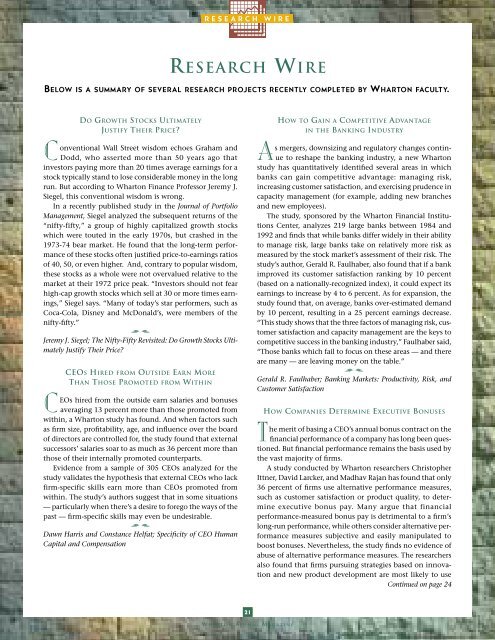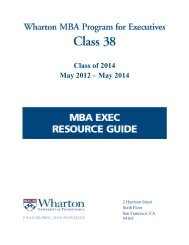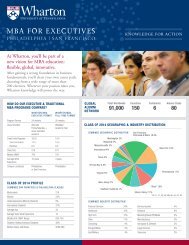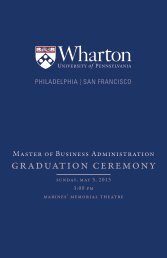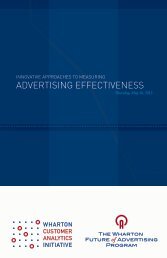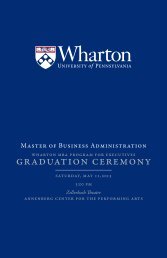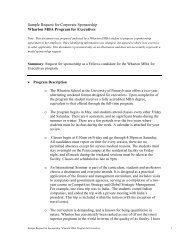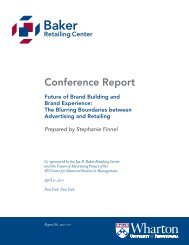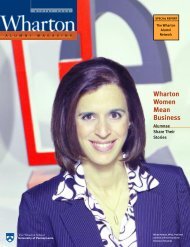wharton's prescription for health care - Wharton Magazine
wharton's prescription for health care - Wharton Magazine
wharton's prescription for health care - Wharton Magazine
Create successful ePaper yourself
Turn your PDF publications into a flip-book with our unique Google optimized e-Paper software.
RESEARCH FEATURE WIRERESEARCH WIREBELOW IS A SUMMARY OF SEVERAL RESEARCH PROJECTS RECENTLY COMPLETED BY WHARTON FACULTY.D O G ROWTH STOCKS ULTIMATELYJUSTIFY THEIR PRICE?Conventional Wall Street wisdom echoes Graham andDodd, who asserted more than 50 years ago thatinvestors paying more than 20 times average earnings <strong>for</strong> astock typically stand to lose considerable money in the longrun. But according to <strong>Wharton</strong> Finance Professor Jeremy J.Siegel, this conventional wisdom is wrong.In a recently published study in the Journal of PortfolioManagement, Siegel analyzed the subsequent returns of the“nifty-fifty,” a group of highly capitalized growth stockswhich were touted in the early 1970s, but crashed in the1973-74 bear market. He found that the long-term per<strong>for</strong>manceof these stocks often justified price-to-earnings ratiosof 40, 50, or even higher. And, contrary to popular wisdom,these stocks as a whole were not overvalued relative to themarket at their 1972 price peak. “Investors should not fearhigh-cap growth stocks which sell at 30 or more times earnings,”Siegel says. “Many of today’s star per<strong>for</strong>mers, such asCoca-Cola, Disney and McDonald’s, were members of thenifty-fifty.”$4Jeremy J. Siegel; The Nifty-Fifty Revisited: Do Growth Stocks UltimatelyJustify Their Price?CEOS HIRED FROM OUTSIDE EARN MORETHAN THOSE PROMOTED FROM WITHINCEOs hired from the outside earn salaries and bonusesaveraging 13 percent more than those promoted fromwithin, a <strong>Wharton</strong> study has found. And when factors suchas firm size, profitability, age, and influence over the boardof directors are controlled <strong>for</strong>, the study found that externalsuccessors’ salaries soar to as much as 36 percent more thanthose of their internally promoted counterparts.Evidence from a sample of 305 CEOs analyzed <strong>for</strong> thestudy validates the hypothesis that external CEOs who lackfirm-specific skills earn more than CEOs promoted fromwithin. The study’s authors suggest that in some situations— particularly when there’s a desire to <strong>for</strong>ego the ways of thepast — firm-specific skills may even be undesirable.$4Dawn Harris and Constance Helfat; Specificity of CEO HumanCapital and CompensationHOW TO GAIN A COMPETITIVE ADVANTAGEIN THE BANKING INDUSTRYAs mergers, downsizing and regulatory changes continueto reshape the banking industry, a new <strong>Wharton</strong>study has quantitatively identified several areas in whichbanks can gain competitive advantage: managing risk,increasing customer satisfaction, and exercising prudence incapacity management (<strong>for</strong> example, adding new branchesand new employees).The study, sponsored by the <strong>Wharton</strong> Financial InstitutionsCenter, analyzes 219 large banks between 1984 and1992 and finds that while banks differ widely in their abilityto manage risk, large banks take on relatively more risk asmeasured by the stock market’s assessment of their risk. Thestudy’s author, Gerald R. Faulhaber, also found that if a bankimproved its customer satisfaction ranking by 10 percent(based on a nationally-recognized index), it could expect itsearnings to increase by 4 to 6 percent. As <strong>for</strong> expansion, thestudy found that, on average, banks over-estimated demandby 10 percent, resulting in a 25 percent earnings decrease.“This study shows that the three factors of managing risk, customersatisfaction and capacity management are the keys tocompetitive success in the banking industry,” Faulhaber said,“Those banks which fail to focus on these areas — and thereare many — are leaving money on the table.”$4Gerald R. Faulhaber; Banking Markets: Productivity, Risk, andCustomer SatisfactionHOW COMPANIES DETERMINE EXECUTIVE BONUSESThe merit of basing a CEO’s annual bonus contract on thefinancial per<strong>for</strong>mance of a company has long been questioned.But financial per<strong>for</strong>mance remains the basis used bythe vast majority of firms.A study conducted by <strong>Wharton</strong> researchers ChristopherIttner, David Larcker, and Madhav Rajan has found that only36 percent of firms use alternative per<strong>for</strong>mance measures,such as customer satisfaction or product quality, to determineexecutive bonus pay. Many argue that financialper<strong>for</strong>mance-measured bonus pay is detrimental to a firm’slong-run per<strong>for</strong>mance, while others consider alternative per<strong>for</strong>mancemeasures subjective and easily manipulated toboost bonuses. Nevertheless, the study finds no evidence ofabuse of alternative per<strong>for</strong>mance measures. The researchersalso found that firms pursuing strategies based on innovationand new product development are most likely to useContinued on page 2421WHARTON ALUMNI MAGAZINE


